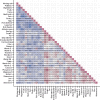The EAT-Lancet diet in relation nutrient intake among older adults: insights from the Gothenburg H70 birth cohort study
- PMID: 40781624
- PMCID: PMC12335021
- DOI: 10.1186/s12937-025-01193-7
The EAT-Lancet diet in relation nutrient intake among older adults: insights from the Gothenburg H70 birth cohort study
Abstract
Background: The EAT-Lancet Commission has proposed a global reference diet aimed at promoting both human health and environmental sustainability. While adherence to this dietary pattern has been associated with reduced risks of chronic disease and lower environmental impact, concerns remain about its ability to meet nutritional requirements - particularly among older adults. The aim was to explore the association between adherence to the EAT-Lancet diet and nutrient intake and adequacy among 70-year-old adults in Gothenburg, Sweden.
Methods: This cross-sectional study included 861 participants from the Swedish population-based Gothenburg H70 Birth Cohort Study (mean age 70.5 years, 55% women). Dietary intake was assessed using a validated diet history interview, and adherence to the EAT-Lancet diet was scored based on 14 food components. Nutrient intake was evaluated against age- and sex-specific recommended intake (RI) levels. Cardiometabolic risk markers and biomarkers of nutritional status, including homocysteine and haemoglobin, were measured. Linear and logistic regression models were used to examine trends across sex-specific tertiles of diet adherence, with sensitivity analyses adjusting for energy intake and comparing adequacy based on average requirement (AR) thresholds.
Results: Higher adherence to the EAT-Lancet diet was linked to higher intake of fibre and polyunsaturated fats, and lower intake of saturated fat and alcohol. Mean protein intake per kilogram body weight/day was similar across adherence tertiles. Intake of beta-carotene, folate, vitamin C, magnesium, potassium, and iron was higher with greater adherence, while retinol equivalents, vitamin B12, niacin equivalents was lower- patterns that remained consistent after energy adjustment. Despite lower B12 intake, homocysteine levels were lowest in the group with highest adherence, and anaemia prevalence did not differ. Micronutrient adequacy improved with higher adherence for vitamin E, folate, vitamin C, magnesium, potassium, and iron. Similar results were observed using average requirement (AR) thresholds in sensitivity analyses.
Conclusions: Adherence to the EAT-Lancet diet was associated with a more favourable nutrient profile in this cohort of older adults, without evidence of widespread micronutrient inadequacy. These findings suggest that environmentally sustainable diets can support adequate nutrition when well-balanced, even in nutritionally vulnerable populations such as older adults.
Keywords: Aging; Nutrient deficiency; Plant-based diets; Sustainable diet.
© 2025. The Author(s).
Conflict of interest statement
Declarations. Ethics approval: The study was approved by the Regional Ethics Review Board in Gothenburg, Sweden (Reference number 869 − 13). All the participants gave written informed consent to participate in the examinations according to the Helsinki declaration. Consent for publication: Not applicable as the manuscript does not contain data from any individual person. Competing interests: SK has served at scientific advisory boards, speaker and / or as consultant for Roche, Eli Lilly, Geras Solutions, Optoceutics, Biogen, Eisai, Merry Life, Triolab, Novo Nordisk and Bioarctic, unrelated to present study content.
Figures
Similar articles
-
Adherence to the EAT-Lancet diet and its association with micronutrient intake in the urban population of eight Latin American countries.Nutr Res. 2025 Jul;139:136-148. doi: 10.1016/j.nutres.2024.12.001. Epub 2024 Dec 6. Nutr Res. 2025. PMID: 40532259
-
Maternal adherence to the EAT-Lancet diet recommendations among pregnant women in Ireland and associations with offspring birth outcomes and childhood adiposity.Eur J Nutr. 2025 Jul 15;64(5):238. doi: 10.1007/s00394-025-03756-0. Eur J Nutr. 2025. PMID: 40665062 Free PMC article.
-
Adherence to EAT-Lancet diet, biological aging, and life expectancy in the UK Biobank: a cohort study.Am J Clin Nutr. 2025 Jul;122(1):29-38. doi: 10.1016/j.ajcnut.2025.04.030. Epub 2025 May 6. Am J Clin Nutr. 2025. PMID: 40339905
-
Folic acid with or without vitamin B12 for cognition and dementia.Cochrane Database Syst Rev. 2003;(4):CD004514. doi: 10.1002/14651858.CD004514. Cochrane Database Syst Rev. 2003. Update in: Cochrane Database Syst Rev. 2008 Oct 08;(4):CD004514. doi: 10.1002/14651858.CD004514.pub2. PMID: 14584018 Updated.
-
Effectiveness and safety of vitamin D in relation to bone health.Evid Rep Technol Assess (Full Rep). 2007 Aug;(158):1-235. Evid Rep Technol Assess (Full Rep). 2007. PMID: 18088161 Free PMC article.
References
-
- Willett W et al. Food in the anthropocene: the EAT-Lancet commission on healthy diets from sustainable food systems. Lancet. 2019. - PubMed
-
- Crippa M, et al. Food systems are responsible for a third of global anthropogenic GHG emissions. Nat Food. 2021;2(3):198–209. - PubMed
-
- IPCC (The Intergovernmental Panel on Climate Change), Climate Change 2022: Mitigation of Climate Change. Contribution of Working Group III to the Sixth Assessment Report of the Intergovernmental Panel on Climate Change. 2022: Cambridge, UK and New York, NY, USA.
-
- Benton TG et al. Food system impacts on biodiversity loss—three levers for food system transformation in support of nature. 2021. https://www.chathamhouse.org/sites/default/files/2021-02/2021-02-03-food....
-
- Scarborough P, et al. Greenhouse gas emissions, land use, water use, water pollution and biodiversity impact of vegans, vegetarians, fish-eaters and meat-eaters in the UK. Nature Food; 2023. https://www.nature.com/articles/s43016-023-00795-w. - PMC - PubMed
MeSH terms
LinkOut - more resources
Full Text Sources
Research Materials


